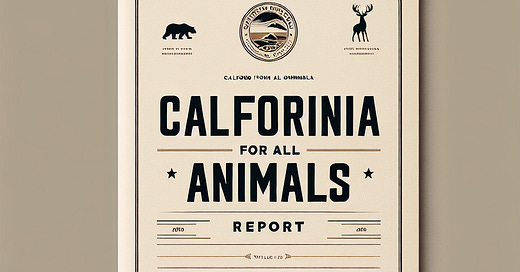California for All Animals: A $50 Million Experiment in Mismanagement
How Flawed Policies and Misallocated Funds Are Fueling a National Shelter Crisis
Introduction: A Broken Promise
In July 2021, California launched “California for All Animals,” a $50 million initiative to transform the state’s animal shelter system and reduce euthanasia. Managed by the Koret Shelter Medicine Program (KSMP) at UC Davis, the state grant requires KSMP to submit two legislative reports—the first submitted in March 2023 and the final is due in 2026.
Alarmingly, the sole report raises serious questions about transparency, priorities, and outcomes. It exposes mismanagement and misaligned priorities—issues now fueling a statewide reckoning, leaving shelters overwhelmed, communities burdened, and animals paying the ultimate price.
A Dangerous National Model: The Consortium’s Influence
KSMP’s reach extends far beyond California. As a leading authority in shelter medicine, KSMP provides the ethical and scientific justification for policies embraced by major national animal welfare organizations. This powerful network, increasingly referred to as “The Consortium” by animal advocates, includes:
Maddie’s Fund
Koret Shelter Medicine Program (KSMP)
Best Friends Animal Society (BFAS) / Shelter Pet Data Alliance (SPDA)
American Society for the Prevention of Cruelty to Animals (ASPCA)
Michelson Found Animals Foundation (MFAF) / Found Animals Registry
PetSmart Charities
National Animal Control Association (NACA)
Human Animal Support Services (HASS)
Kristen Hassen’s Outcomes Consulting
While no formal “consortium” exists, the alignment of these organizations around policies such as Managed Intake and Community Animals suggests a shared strategic agenda—one that may not always prioritize the best interests of animals or communities.
By promoting KSMP’s policies as national best practices they are rapidly being adopted by shelters across the country. Critics argue that these policies create a crisis narrative that positions these organizations as indispensable problem-solvers. Some have even raised concerns that certain Consortium members might have financial incentives—such as fundraising campaigns, services, or products that align with their own revenue streams—that could influence these policy recommendations.
Shelters Without Walls: The Problem with Managed Intake
At the heart of California’s initiative is the controversial policy of Managed Intake, which allows shelters to turn away animals unless they meet strict, urgent criteria. Proponents argue that this practice aligns shelter admissions with limited resources. Critics contend that Managed Intake shifts professional care responsibilities onto private citizens without adequate resources or support.
The KSMP report cites a nearly 60% drop in euthanasia during the pandemic—a figure driven largely by extraordinary conditions. In 2020, public health measures such as shelter closures and reduced admissions, combined with surges in fostering and adoptions, temporarily lowered the number of animals entering shelters. KSMP has since used these transient statistics to justify Managed Intake protocols. However, as pandemic-era protections fade, a stark reality has emerged: euthanasia rates are climbing again, despite intake remaining lower than pre-pandemic levels.
For example, Los Angeles Animal Services reported a 72% increase in euthanasia in 2024, even though fewer animals are entering shelters than before the pandemic. This suggests that while fewer animals are admitted overall, many of those that do enter—often unaltered, sick, or behaviorally deteriorated strays that were turned away due to Managed Intake policies—ultimately return in worse condition and less adoptable, making euthanasia more likely.
Sacramento’s experience further illustrates the problem. When Sacramento Animal Control Services implemented Managed Intake protocols in 2020, they recorded a staggering 478% increase in community fostering as residents were forced to care for animals that shelters refused to admit. Critics argue that this policy merely outsourced the responsibilities of professional care to private citizens without providing them with sufficient resources or support. As these informal networks become overwhelmed, more animals ultimately return to shelters in worse condition—leading to an inevitable increase in euthanasia.
The "Sniptember" Disaster: $37 Million in Unmet Demand
A particularly glaring example of misaligned priorities is the “Sniptember” grant cycle—designed to expand access to critical spay/neuter services. Despite shelters requesting nearly $46 million for critical spay/neuter services, only $8.67 million was allocated—while $12.5 million was spent on administrative activities, and $15.5 million on cat cage portals.
Adding to these concerns, the Sacramento SPCA received a $750,000 grant from KSMP in 2022 despite having nearly $25 million in assets at the time. While emphasizing financial transparency through its website and IRS filings, there is little public reporting on how these funds were applied to expand programs or services—raising questions about whether they effectively addressed urgent shelter needs.
Similarly, the San Diego Humane Society—one of California’s wealthiest animal welfare organizations—received a $727,182 grant under the California for All Animals initiative despite its extensive financial resources. In 2023 alone, SDHS reported total revenue of $67.5 million and total assets exceeding $125 million. Despite this robust financial position, the organization was a major beneficiary of a state grant meant to address urgent shelter needs across California.
Critics argue that allocating funds to such well-resourced organizations represents a missed opportunity to support smaller shelters in underserved areas like Kern County and Fresno, where overpopulation and veterinary shortages are far more acute. The lack of transparency around how these funds were awarded and then used further raises questions about whether they were effectively applied to address systemic challenges or simply reinforced existing inequities in California’s shelter system.
The failure to adequately fund direct services, coupled with high administrative costs, appears to have exacerbated overpopulation and, ultimately, the need for euthanasia.



Accountability on Hold: The Unacceptable Feedback Loop
The March 2023 report exposes a stark contradiction between KSMP’s official claims and its actual expenditures. In September 2023, KSMP’s CA State Director Allison Cardona asserted that most funding had been allocated toward spay/neuter and accessible veterinary care.
Yet the report clearly shows:
Only $8.67 million was distributed for spay/neuter programs—far below the $46 million requested by shelters. Much of this funding went to well-resourced organizations rather than underserved areas with acute needs.
Over $12.5 million was spent on administrative activities like site visits, webinars, and boot camps.
Another $15.5 million was spent on cat cage portals, even though Managed Intake policies discouraged shelters from admitting cats.
These figures were publicly available when Cardona made her claims, suggesting either a failure to review the actual budget breakdown or an intentional misrepresentation. With no independent oversight and the final report not due until 2026, a three-year gap in transparency looms over this $50 million program. If KSMP leadership continues to make misleading statements, how can the public trust that taxpayer funds are being used responsibly?
The Consequences: A Crisis Spreading Nationwide
California’s shelter crisis is not an isolated failure—it is a case study in mismanagement that is rapidly being exported. Managed Intake, underfunded spay/neuter programs, and the model of community-based sheltering promoted by KSMP are now being adopted by shelters across the country under the guidance of the Consortium. California’s experience offers a dire warning: these policies, far from saving lives, may lead to increased euthanasia, shelter overcrowding, and a surge in unsterilized stray populations.
The increase in euthanasia over the past year illustrate the human and animal cost of these policies. Despite a $50 million investment, KSMP’s spending priorities raise serious questions about whether funds are truly being used to address the shelter crisis.
Final Takeaway: The Time to Act is Now
The California for All Animals initiative, once heralded as a lifeline for shelters and communities, now stands as a cautionary tale of misdirected priorities and systemic mismanagement. Unless state and national policymakers demand independent audits, implement stricter accountability measures, and challenge the influence of the Consortium, these flawed policies will continue—with devastating consequences for communities and countless animals.
Ed Boks is a former Executive Director of the New York City, City of Los Angeles, and Maricopa County Animal Care & Control Departments, and a former Board Director of the National Animal Control Association. His work has been published in the LA Times, New York Times, Newsweek, Real Clear Policy, Sentient Media, and now on Animal Politics with Ed Boks.






Oversight should require more than two reports for that amount of funding! - monthly reports or at least quarterly reports.
In addition, horrifying how little was allocated to true prevention (s/n) in a grant intended to reduce euthanasias. The chief element in "access to care" needs to be s/n, but instead "access to care" is a euphemism for other "services."
The scary thing is that an alarming number of shelters take the word of the "experts" and follow procedures and policies that are clearly taking us backward. Your explanation of how that happens is a very clear one.
There are one or two statewide funds set up to implement the solution that are working well. We need to take a look at them and provide a few good examples which stand out in this miasma. Thirty years of work are being undone.
Thank you for writing about this travesty, Ed.
California's $50 Million Fiasco has not only made the situation worse for animals throughout the state, but worse for our chances of ever getting another opportunity for spay/neuter funding from the California government. Any legislator evaluating how this money has been spent, and the concurrent drastic increase in unwanted animals (both those in shelters as well as those abandoned to the "community"), would have to conclude that it has been a terrible waste of government funds (taxpayer funds), and would thus be inclined to deny any further requests for funding for this problem.